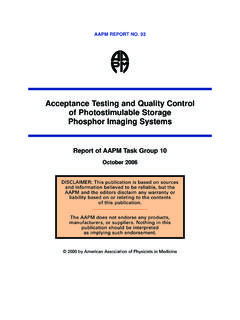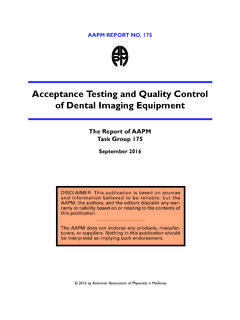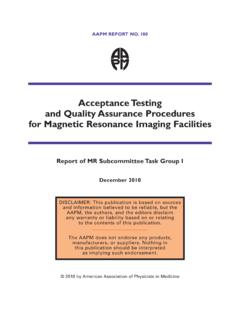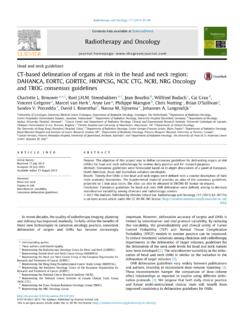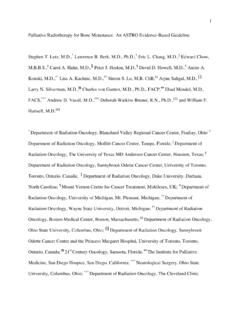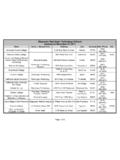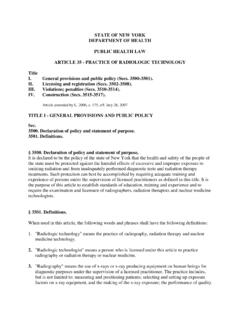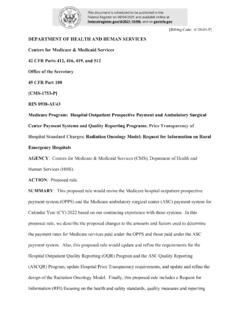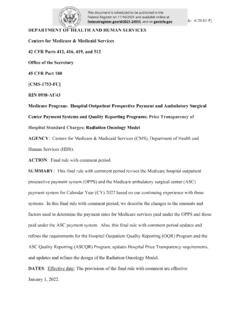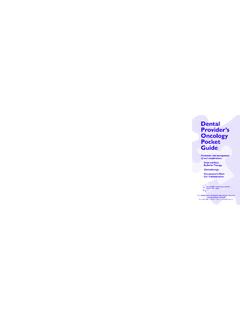Transcription of TG-263: Standardizing Nomenclatures in Radiation Oncology
1 AAPM REPORT NO. 263 Standardizing Nomenclaturesin Radiation OncologyThe Report of AAPMTask Group 263 January 2018 DISCLAIMER: This publication is based on sourcesand information believed to be reliable, but theAAPM, the authors, and the editors disclaim any war-ranty or liability based on or relating to the contents ofthis AAPM does not endorse any products, manufac-turers, or suppliers. Nothing in this publication shouldbe interpreted as implying such endorsement. 2018 by American Association of Physicists in MedicineThis page intentionally left Nomenclaturesin Radiation OncologyThe Report of AAPM Task Group 263 Charles S. Mayo, ChairUniversity of Michigan, Ann Arbor, MichiganJean M. Moran, Vice ChairUniversity of Michigan, Ann Arbor, MichiganWalter BoschWashington University, St. Louis, MissouriYing XiaoUniversity of Pennsylvania, Philadelphia, PennsylvaniaTo d d M c N u t tJohns Hopkins University, Baltimore, MarylandRichard PoppleUniversity of Alabama at Birmingham, Birmingham, AlabamaJeff MichalskiWashington University, St.
2 Louis, MissouriMary FengUniversity of California San Francisco, San Francisco, CaliforniaLawrence B. MarksUniversity of North Carolina, Chapel Hill, North CarolinaClifton D. FullerMD Anderson Cancer Center, Houston, TexasEllen YorkeMemorial Sloan Kettering Cancer Center, New York, New YorkJatinder PaltaVirginia Commonwealth University, Richmond, VirginiaPeter E. GabrielUniversity of Pennsylvania, Philadelphia, PennsylvaniaAndrea MolineuMD Anderson Cancer Center, Houston, TexasMartha M. MatuszakUniversity of Michigan, Ann Arbor, MichiganElizabeth CovingtonBirmingham, AlabamaKathryn MasiKarmanos Cancer Center, Detroit, MichiganSusan L. RichardsonSwedish Medical Center, Seattle, WashingtonTimothy RitterHunter Holmes McGuire VA Medical Center, Richmond, VirginiaTo m a s z M o rga sVarian Medical Systems, Palo Alto, CaliforniaStella FlampouriUniversity of Florida, Jacksonville, FloridaLakshmi SantanamWashington University, St. Louis, MissouriJoseph A. MooreJohns Hopkins University, Baltimore, MarylandThomas G.
3 PurdieThe Princess Margaret Cancer Center, Toronto, ON, CanadaRobert MillerMayo Clinic, Jacksonville, FloridaCoen HurkmansCatharina Hospital, department of Radiation Oncology , Eindhoven, The NetherlandsJudy AdamsMassachusetts General Hospital, Boston, MassachusettsQing-Rong Jackie WuDuke University, Durham, North CarolinaColleen J. FoxDartmouth-Hitchcock Medical Center, Lebanon, New HampshireRamon Alfredo SiochiWest Virginia University, Morgantown, West VirginiaNorman L. BrownBaptist Medical Center, Jacksonville, FloridaWilko VerbakelVU University Medical Center, Amsterdam, NetherlandsYves ArchambaultVarian Medical Systems, Palo Alto, CaliforniaSteven J. ChmuraUniversity of Chicago, Chicago, IllinoisDon G. EagleNorthwest Medical Physics Center, Lynnwood, WashingtonThomas J. FitzgeraldUniversity of Massachusetts, Worcester, MassachusettsAndre L. DekkerDepartment of Radiation Oncology (MAASTRO), GROW School for Oncology and Developmental Biology, Maastricht University Medical Centre+, Maastricht, The NetherlandsTheodore HongMassachusetts General Hospital, Boston, MassachusettsRishabh KapoorVirginia Commonwealth University, Richmond, VirginiaBeth LansingElekta Corporation, St.
4 Louis, MissouriShruti JollyUniversity of Michigan, Ann Arbor, MichiganMary E. NapolitanoConsultant, Suwanee, GeorgiaJames PercyElekta Corporation, St. Louis, MissouriMark S. RoseSun Nuclear, Melbourne, FloridaSalim SiddiquiHenry Ford Health System, Detroit, MichiganChristof SchadtBrain Lab, Chicago, IllinoisWilliam E. SimonSun Nuclear Corporation, Melbourne, FloridaWilliam L. StraubeWashington University, St. Louis, MissouriSara T. St. JamesUniversity of Washington, Seattle, WashingtonKenneth UlinUniversity of Massachusetts, Worcester, MassachusettsSue S. YomUniversity of California San Francisco, San Francisco, CaliforniaTo r u n n Yo c kMassachusetts General Hospital, Boston, MassachusettsDISCLAIMER: This publication is based on sources and information believed to be reliable,but the AAPM, the authors, and the publisher disclaim any warranty or liabilitybased on or relating to the contents of this AAPM does not endorse any products, manufacturers, or suppliers. Nothing in thispublication should be interpreted as implying such : 978-1-936366-61-3 ISSN: 0271-7344 2018 by American Association of Physicists in MedicineAll rights reservedPublished byAmerican Association of Physicists in Medicine1631 Prince StreetAlexandria, VA 22314 THE REPORT OF AAPM TASK GROUP 263: Standardizing Nomenclatures in Radiation .
5 Pooling .. Communication During Routine Care .. Data Extraction and Exchange.. Despite Some Progress .. 73. Task Group Initiation and Membership .. Evaluation of Current Nomenclature Practices .. and Volume Units .. Structure Nomenclature .. for Target Structures .. and Planning Structures .. and DICOM Limitations .. Standards .. Model of Anatomy .. CT .. Structure Interpreted Types .. Dose and Imaging Information Specification .. Considerations for DICOM Dose and Imaging Specification .. Specification .. for Non-Target Structure Nomenclature.. Principles for Non-Target Nomenclature .. Nomenclature List .. for Target Structure Nomenclature .. Principles for Target Nomenclature.. for Dose Volume Histogram Metrics .. for DVH Curve Metrics .. 2410. Recommendations for Distinguishing Metrics of Segmented vs Non-Segmented Target Structures .. 2511. Recommendations to Vendors .. 2612. Nomenclature Pilot Study Design and Results.
6 Pilot Study Design .. Pilot Study Results .. 3013. Recommendations for Implementation .. 3214. Recommendations for Clinical Trial Study Groups .. 3315. Recommendations for Working Group to Succeed Task Group.. 3316. Summary of Key Take-Home Points .. 3417. Acknowledgments .. 3518. References .. 36 THE REPORT OF AAPM TASK GROUP 263: Standardizing Nomenclatures in Radiation Oncology61. IntroductionThe Radiation Oncology community can benefit from standardized Nomenclatures applied to targets,normal tissue structures, and treatment planning concepts and metrics. Such conformity enhancessafety and quality efforts within and between clinics for routine ongoing practice, and it enables datapooling for outcomes research, registries, and clinical trials. Standardization is a vital precursor to thedevelopment of scalable uses of scripting for quality assurance and treatment plan evaluation3,22, clarity and consistency through Standardizing Nomenclatures in these areas would providebroad benefits.
7 The charge of AAPM Task Group 263 is to provide nomenclature guidelines in Radiation oncologyfor use in clinical trials, data-pooling initiatives, population-based studies, and routine clinical care bystandardizing:1. structure names across image processing and treatment planning system platforms; 2. nomenclature for dosimetric data ( , dose/volume histogram [DVH]-based metrics);3. templates for clinical trial groups and users of an initial subset of software platforms to facili-tate adoption of the standards; and4. formalism for nomenclature schema which can accommodate the addition of other structures defined in the Background Much has been learned from the groups which have instituted standardized Nomenclatures for struc-tures and for DVH metrics to facilitate development of outcomes databases, automated analysis ofDVH metrics, and inter-institutional data 5 While some standards for structures have beenpublished,1,2 no single standard has been generally endorsed with multi-institutional and multi-vendorconsensus.
8 In addition, the standards that exist have generally not been comprehensive ( , providingsubsets but not the full set of dose/volume metrics, vendor system constraints, generalizability, norradiobiological factors). Data Pooling A key vision of the QUANTEC collaboration was promotion of a culture of data pooling among insti-tutions to promote dose/volume/outcome research6,7. The QUANTEC papers highlighted the impor-tance of Standardizing what data elements are collected and how they are reported to reduce barriers todevelopment of shared wisdom through efficient use of combined data sets. At approximately thesame time, the value of standardizations to improve quality assurance in clinical trials was highlight-ed8. The Imaging and Radiation Oncology Core (IROC) group was established as part of the NationalClinical Trials Network (NCTN) to carry out clinical trial quality assurance. The National CancerInstitute (NCI) reorganized the clinical trials system in early 2014 by forming the NCTN to better pro-mote large, multi-institutional trials.
9 To promote participation of a broad range of institutions in clini-cal trials, it is critical to provide physicists, physicians, and other personnel with tools and methodswithin their clinics to efficiently support submission of high-quality data to the clinical trial qualityassurance (QA) centers. The movement of professional organizations toward expectations for datasharing and similar requirements for publication in some journals is growing stronger 9 12. Standard-ization is a crucial component in making shared data more accessible and usable to benefit patientcare. AAPM Task Group 113 recommends Standardizing nomenclature because it facilitates interac-tion between all participants in clinical trials, ranging from the personnel at the institution performingTHE REPORT OF AAPM TASK GROUP 263: Standardizing Nomenclatures in Radiation Oncology7the planning and quality steps to the quality assurance centers and principal investigators who areresponsible for reviewing submitted Facilitating Communication During Routine Care As part of routine patient care, establishing a common nomenclature used by clinics and vendorsenables an improved exchange of data for patients who visit multiple A common nomencla-ture also improves safety by minimizing variability and ambiguity.
10 The nomenclature is also animportant enabling factor for construction of software solutions that can automate portions of the planquality control process and improve ,14 16 The National Patient Safety Agency and the Radiation Oncology Safety Information System(ROSIS) published adverse events (or incidents) in Radiation therapy and reported that they were pri-marily due to wrong communication of intent .17,18 Similarly, the Radiation Oncology IncidentLearning System, sponsored by ASTRO and AAPM, has identified miscommunication of the radia-tion therapy prescription as a problem19. As a result, improved communication in Radiation therapy is acornerstone of ASTRO s white paper on Standardizing dose These reports documentthe deleterious effects of inaccurate or incomplete structure names is one of the key factors that needs attention. Integration of stan-dardized structure names into the Digital Imaging and Communications in Medicine (DICOM) stan-dard or the Integrating the Healthcare Enterprise in Radiation Oncology (IHE-RO) Integration Profilescan pave the way toward safe transfer of information and, in turn, help automate QA processes.

